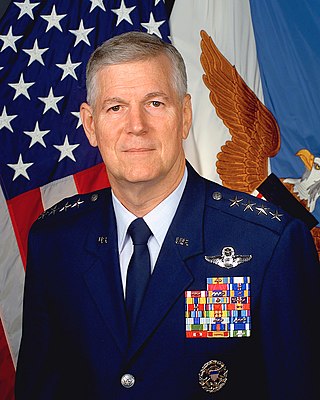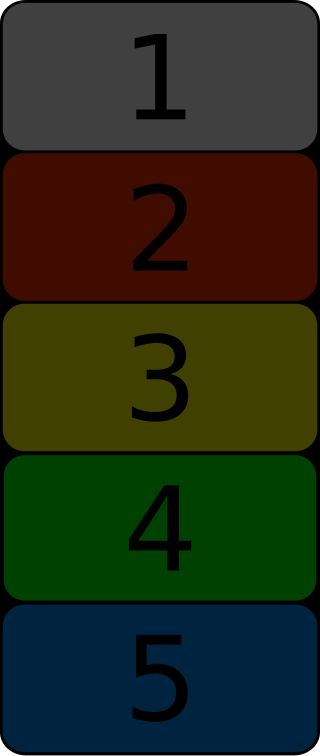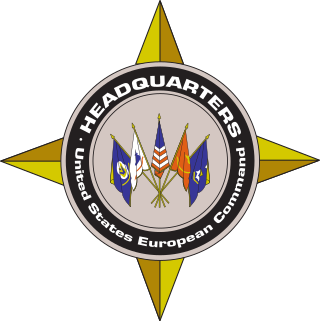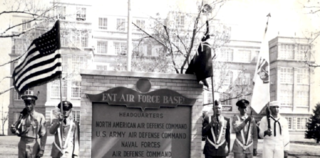
Richard Bowman Myers is a retired United States Air Force general who served as the 15th chairman of the Joint Chiefs of Staff. As chairman, Myers was the highest ranking uniformed officer of the United States military forces. He also served as the 14th president of Kansas State University from 2016 to 2022.

The Joint Chiefs of Staff (JCS) is the body of the most senior uniformed leaders within the United States Department of Defense, which advises the president of the United States, the secretary of defense, the Homeland Security Council and the National Security Council on military matters. The composition of the Joint Chiefs of Staff is defined by statute and consists of a chairman (CJCS), a vice chairman (VJCS), the chiefs of the Army, Marine Corps, Navy, Air Force, Space Force, and the chief of the National Guard Bureau. Each of the individual service chiefs, outside their JCS obligations, works directly under the secretaries of their respective military departments, e.g. the secretary of the Army, the secretary of the Navy, and the secretary of the Air Force.

The defense readiness condition (DEFCON) is an alert state used by the United States Armed Forces. For security reasons, the US military does not announce a DEFCON level to the public.

The Secretary of the Air Force, sometimes referred to as the Secretary of the Department of the Air Force, is the head of the Department of the Air Force and the service secretary for the United States Air Force and United States Space Force. The secretary of the Air Force is a civilian appointed by the president, by and with the advice and consent of the Senate. The secretary reports to the secretary of defense and/or the deputy secretary of defense, and is by statute responsible for and has the authority to conduct all the affairs of the Department of the Air Force.

The chairman of the Joint Chiefs of Staff (CJCS) is the presiding officer of the Joint Chiefs of Staff (JCS). The chairman is the highest-ranking and most senior military officer in the United States Armed Forces and the principal military advisor to the president, the National Security Council, the Homeland Security Council, and the secretary of defense. While the chairman of the Joint Chiefs of Staff outranks all other commissioned officers, the chairman is prohibited by law from having operational command authority over the armed forces; however, the chairman assists the president and the secretary of defense in exercising their command functions.

The Goldwater–Nichols Department of Defense Reorganization Act of October 4, 1986 made the most sweeping changes to the United States Department of Defense since the department was established in the National Security Act of 1947 by reworking the command structure of the U.S. military. It increased the powers of the chairman of the Joint Chiefs of Staff and implemented some of the suggestions from the Packard Commission, commissioned by President Reagan in 1985. Among other changes, Goldwater–Nichols streamlined the military chain of command, which now runs from the president through the secretary of defense directly to combatant commanders, bypassing the service chiefs. The service chiefs were assigned to an advisory role to the president and the secretary of defense, and given the responsibility for training and equipping personnel for the unified combatant commands.

The chief of staff of the Air Force is the service chief of the United States Air Force. They are the principal military advisor to the secretary of the Air Force on matter pertaining to the Air Force. They are a member of the Joint Chiefs of Staff, and thereby a military adviser to the National Security Council, the secretary of defense, and the President. The chief of staff is typically the highest-ranking officer on active duty in the Air Force, unless the chairman and/or the vice chairman of the Joint Chiefs of Staff are Air Force officers.

The United States Space Command is a unified combatant command of the United States Department of Defense, responsible for military operations in outer space, specifically all operations 100 kilometers and greater above mean sea level. U.S. Space Command is responsible for the operational employment of space forces that are provided by the uniformed services of the Department of Defense.

The United States Indo-Pacific Command (USINDOPACOM) is the unified combatant command of the United States Armed Forces responsible for the Indo-Pacific region.

The United States Strategic Command (USSTRATCOM) is one of the eleven unified combatant commands in the United States Department of Defense. Headquartered at Offutt Air Force Base, Nebraska, USSTRATCOM is responsible for strategic nuclear deterrence, global strike, and operating the Defense Department's Global Information Grid. It also provides a host of capabilities to support the other combatant commands, including integrated missile defense; and global command, control, communications, computers, intelligence, surveillance, and reconnaissance (C4ISR). This command exists to give "national leadership a unified resource for greater understanding of specific threats around the world and the means to respond to those threats rapidly".

The United States Transportation Command (USTRANSCOM) is one of the eleven unified commands of the United States Department of Defense. In both times of peace and war, USTRANSCOM's role is to provide the Department of Defense with air, land, and sea transportation. USTRANSCOM was founded in 1987 and is based at Scott Air Force Base in Illinois.

The United States Joint Forces Command (USJFCOM) was a Unified Combatant Command of the United States Department of Defense. USJFCOM was a functional command that provided specific services to the military. The last commander was Army Gen. Ray Odierno and the Command Senior Enlisted was Marine Sergeant Major Bryan B. Battaglia. As directed by the President to identify opportunities to cut costs and rebalance priorities, Defense Secretary Robert Gates recommended that USJFCOM be disestablished and its essential functions reassigned to other unified combatant commands. Formal disestablishment occurred on 4 August 2011.

The United States European Command (EUCOM) is one of the eleven unified combatant commands of the United States military, headquartered in Stuttgart, Germany. Its area of focus covers 21,000,000 square miles (54,000,000 km2) and 51 countries and territories, including Europe, The Caucasus, Russia and Greenland. The Commander of the United States EUCOM simultaneously serves as the Supreme Allied Commander, Europe (SACEUR) within NATO, a military alliance. During the Gulf War and Operation Northern Watch, EUCOM controlled the forces flying from Incirlik Air Base.

The Joint Forces Staff College (JFSC), located in Norfolk, Virginia, was established as the Armed Forces Staff College in 1946 and incorporated into the National Defense University in August 1981. It educates and acculturates joint and multinational warfighters to plan and lead at the operational level. Military operations increasingly require the Armed Services to work jointly, and JFSC provides students the tools to operate in a joint environment. JFSC is composed of three schools, each with different student populations and purposes.

The United States Department of Defense is an executive branch department of the federal government of the United States charged with coordinating and supervising all agencies and functions of the U.S. government directly related to national security and the United States Armed Forces. As of June 2022, the U.S. Department of Defense is the largest employer in the world, with over 1.34 million active-duty service members, including soldiers, marines, sailors, airmen, and guardians. The Department of Defense also maintains over 778,000 National Guard and reservists, and over 747,000 civilians bringing the total to over 2.87 million employees. Headquartered at the Pentagon in Arlington County, Virginia, just outside Washington, D.C., the Department of Defense's stated mission is to provide "the military forces needed to deter war and ensure our nation's security".

The United States Atlantic Command was a Unified Combatant Command of the United States Department of Defense. In 1999, U.S. Atlantic Command was renamed and given a new mission as United States Joint Forces Command.

The United States Department of Defense (DoD) has a complex organizational structure. It includes the Army, Navy, the Marine Corps, Air Force, Space Force, the Unified combatant commands, U.S. elements of multinational commands, as well as non-combat agencies such as the Defense Intelligence Agency and the National Security Agency. The DoD's annual budget was roughly US$496.1 billion in 2015. This figure is the base amount and does not include the $64.3 billion spent on "War/Non-War Supplementals". Including those items brings the total to $560.6 billion for 2015.

Far East Command (FECOM) was a unified combatant command of the United States Department of Defense, active from 1947 until 1957, functionally organised to undertake the occupation of Japan and Korea. The 1st and 6th Marine Divisions, who from 1945 to 1948 assisted the Chinese government in occupying northern China, disarming the Japanese, and helping the Kuomintang Chinese without fully getting involved in the Chinese Civil War, were not part of Far East Command and reported to Pacific Command and the U.S. Navy.

Continental Air Defense Command (CONAD) was a Unified Combatant Command of the United States Department of Defense, tasked with air defense for the Continental United States. It comprised Army, Air Force, and Navy components. It included Army Project Nike missiles anti-aircraft defenses and USAF interceptors. The primary purpose of continental air defense during the CONAD period was to provide sufficient attack warning of a Soviet bomber air raid to ensure Strategic Air Command could launch a counterattack without being destroyed. CONAD controlled nuclear air defense weapons such as the 10 kiloton W-40 nuclear warhead on the CIM-10B BOMARC. The command was disestablished in 1975, and Aerospace Defense Command became the major U.S. component of North American Air Defense Command (NORAD).
Army Service Component Commands (ASCCs) are U.S. Army commands responsible for recommendations to the Joint Force Commander on the allocation and employment of U.S. Army forces within a unified combatant command (CCMD) or further assigned to a subordinate unified command.












































